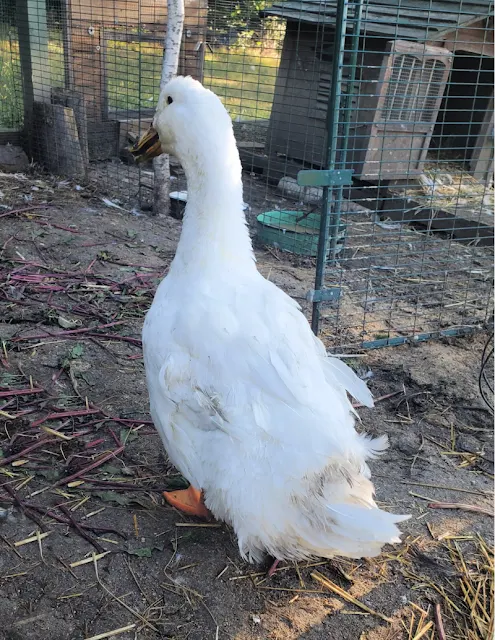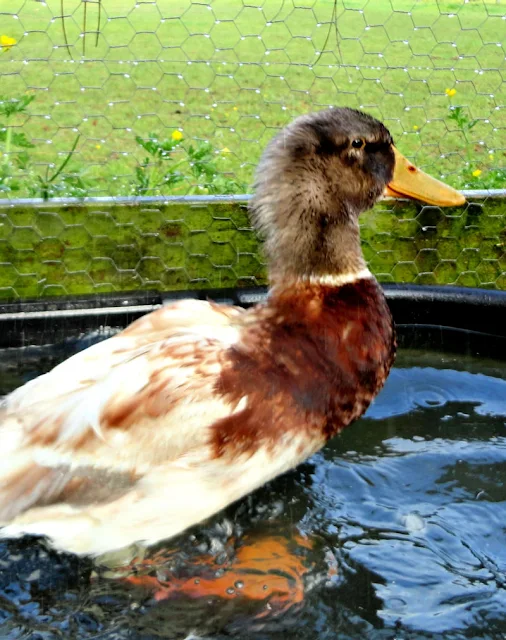Ducks Molt Too!
Molting, or dropping old feathers and regrowing new ones, is critically important for poultry and wild birds of all types, since their feathers keep them warm and insulated in the winter.
New, clean feathers also reduce the chance they'll contract mites or other parasites.
Their feathers enable wild birds to fly so they can migrate and escape predators, help the males of the species attract females during mating season, and in the case of water fowl, allow them to float on the water.
Chickens molt and ducks are no different.
Ducks molt too.
However the way ducks molt is very different.
When you raise chickens, you become accustomed to your flock molting pretty much all at the same time, once a year in the fall.
The shorter days signal their bodies to drop their old, broken feathers and grow in a nice new set before winter arrives to help them stay warm.
It's pretty easy to spot a molting chicken. She will have bare spots starting at her head and neck and moving down her body, with sharp quills poking through.
The pattern of the molt in chickens always follows the same pattern - from her head and neck, down the body and wings, to the tail.
With ducks, its not as obvious. They don't lose feathers in the same pattern, nor will you notice bare spots. Often your only sign that molting is going on will be a run full of feathers and your drakes changing from brightly colored to more monotone over the course of the year.
Otherwise you might not even notice the molt.
But ducks molt too!
However instead of going through a molt that moves down their body in sequence over the course of a few weeks or months like chickens, ducks tend to drop their outer feathers gradually one by one over the course of the year.
This way, they still retain their ability to float and stay waterproof while they're swimming.
In addition, the molting process in ducks is a bit different.
Ducks can molt several times throughout the year instead of only once in the fall. And they molt differently depending on if they're male or female.
Ducks Molt Several Times Throughout the Year
Instead of just the annual fall molt, duck molts can consist of:
- Spring/summer molt for females
- Juvenile molt for young ducks
- Nuptial molt for males
- Eclipse molt for males
- Simultaneous wing molt for both sexes
In molting ducks, unlike molting chickens, the pattern of the molt varies depending on the type of molt it is.
Ducks also tend to molt faster than chickens, with the entire process taking only a few weeks. Some chickens can take months to completely finish their molt.
Since wild ducks depend on their feathers to fly, they need to be able to regrow their feathers more quickly. Although domestic ducks have been bred not to fly, their still maintain that quick turnaround o growing in new feathers.
Males Molt Differently Than Females
Ducks molt differently depending on whether they are male or female. Female ducks generally molt only once a year in the late spring/early summer. This coincides when she would have ducklings to care for.
She'll use the feathers she's shedding to literally "feather her nest". She'll drop her outer feathers, but keep her nice soft down which will help keep any eggs she's sitting on warm and also keep her ducklings warm once they hatch.
Since a molting wild duck can't fly, this keeps her grounded while the ducklings are small, and then she'll regrow a brand new set of feathers later in the summer when the babies are ready to start flying.
Since neither she nor the little ones can fly at this point, she will lead them into the nearby water for safety if there's a lurking predator (this is why wild ducks generally like to build their nests and lay their eggs by the edge of a pond or lakeside).
The Juvenile Molt
By about 6-7 weeks old, ducklings grow their first set of feathers. Both male and female ducklings usually look the same at this point.
But several weeks later, they will drop those first "juvenile" feathers and grow in feathers colored differently, depending on their sex.
The Nuptial Molt
Male ducks of nearly every breed are more brightly colored than the females.
The male ducks (drakes) molt at least twice a year. In the late winter/early spring, they drop their dull winter feathers and grow in some colorful new feathers for the upcoming mating season in order to impress the ladies.
This isn't a full-on molt usually, just a partial one, and is called their "nuptial" molt. You'll notice some nice colorful wing feathers, a darker head and an overall flashy look getting ready to woo the females.
The Eclipse Molt
Once mating season is over at the end of the summer, the drake will undergo his major molt, called an "eclipse" molt. Over the course of several weeks, he'll drop his fancy feathers and they'll be replaced with plain, drab camouflage feathers (this is helpful for keeping wild ducks safe during hunting season from both human hunters and predators!).
This time of year the male will look very similar to the female duck, helping him to blend in with his environment. Male and female ducks will both go through an eclipse molt about the same time.
During the eclipse molt, the ducks will not only lose their feathers, they'll also lose most of their down. These are the bits of fluff that you'll notice all over the ground. The down helps to insulate the ducks and keep them warm, so summer is the obvious time of year to shed and regrow the down.
The females will regrow their flight feathers. Male ducks usually retain their wing feathers, so they can fly year round as a defense against predators.
The Simultaneous Wing Molt
Many ducks also go through a third molt called a "simultaneous" molt. This is in comparison to the "sequential" molt that chickens go through with the molting pattern traveling down the body. The simultaneous molt happens quickly and the feathers all drop at the same time.
It is during this molt that they regrow new wing feathers, so they're grounded and unable to fly and therefore extremely vulnerable to predators for those few weeks (although of course domestic ducks can't fly anyway, so it's irrelevant to them).
Interestingly, most other types of birds molt by losing only one wing feather at a time so they can still fly if they need do.
What Should you Do to Help?
You really don't need to do anything differently while your ducks are molting, but during the molting season, they will likely eat more. Feathers are almost 90% protein, so your ducks will be needing additional protein and energy to grow in new feathers.
There are lots of sources of plant protein that you can add to your ducks' diet when they're molting to help them along, and if you can let them out to free range, they'll gobble up all kinds of bugs, earthworms, small snakes, grubs, and even toads and lizards.
Your ducks will also love extra rations of basil, dill, parsley, and tarragon! These herbs are high in protein. And will enjoy meat, fish or shellfish scraps, shells and skins, feeder fish or dried insects.
I don't recommend feeding them cat food (I feel the need to mention this because it seems to be a fairly common question) since it's formulated for cats not waterfowl, but you can switch from a layer feed to a grower or meat bird feed, which both are a bit higher in protein. You can also offer them regular canned fish like mackerel or sardines.
Reduction in Laying
Egg laying will slow down or stop during the duck molting season. Regrowing new feathers takes all the energy from the female ducks. This also makes sense because a mother duck has no business laying eggs (more potential babies!) while she's raising her spring ducklings.
But unlike chickens though, who generally stop laying during the fall molt and then take a long winter break until spring when the days get longer, our ducks will start laying again once they're done molting.
Signs of the Molt
During the molt, your ducks might seem a bit more subdued than normal or look a bit moth-eaten. You want to be careful handling them while they're molting because new feathers can easily break off and will bleed.
You will likely notice fluff on your ducks' bills when they're molting, since they seem to preen more when they're dropping feathers, and you'll notice lots of fluff and feathers in their swimming pool, coop and run area.
The most obvious sign that your ducks are molting is that your coop and run will look like there was a pillow fight, early snow fall, predator attack - or like one of your ducks exploded!
The above information applies to wild ducks primarily.
It's very hard to find much information about whether the domestication of ducks has had an impact on their molting habits, but from observing my own ducks, they do seem to molt more than once a year, in fact I believe I've used the term "perma molt" when it comes to our ducks!
Either way, they need to grow in nice new feathers each year, just like chickens do. They just do it a bit differently.
For more information and advice about raising backyard ducks, visit my Duck Care Guide.
Pin This!









































